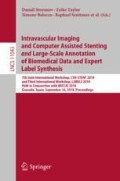Abstract
A key component to the success of deep learning is the availability of massive amounts of training data. Building and annotating large datasets for solving medical image classification problems is today a bottleneck for many applications. Recently, capsule networks were proposed to deal with shortcomings of Convolutional Neural Networks (ConvNets). In this work, we compare the behavior of capsule networks against ConvNets under typical datasets constraints of medical image analysis, namely, small amounts of annotated data and class-imbalance. We evaluate our experiments on MNIST, Fashion-MNIST and medical (histological and retina images) publicly available datasets. Our results suggest that capsule networks can be trained with less amount of data for the same or better performance and are more robust to an imbalanced class distribution, which makes our approach very promising for the medical imaging community.
Access this chapter
Tax calculation will be finalised at checkout
Purchases are for personal use only
Notes
References
MICCAI Grand Challenge Tumor Proliferation Assessment Challenge (TUPAC16). http://tupac.tue-image.nl/. Accessed 18 Jan 2018
Albarqouni, S., Baur, C., Achilles, F., Belagiannis, V., Demirci, S., Navab, N.: Aggnet: deep learning from crowds for mitosis detection in breast cancer histology images. IEEE Trans. Med. Imaging 35(5), 1313–1321 (2016)
Cardoso, M.J., et al. (eds.): Intravascular Imaging and Computer Assisted Stenting, and Large-Scale Annotation of Biomedical Data and Expert Label Synthesis: 6th Joint International Workshops, CVII-STENT and Second International Workshop, LABELS (2017), held in Conjunction with MICCAI 2017 (2017)
Glorot, X., Bengio, Y.: Understanding the difficulty of training deep feedforward neural networks. In: International Conference on Artificial Intelligence and Statistics, vol. 9, pp. 249–256. PMLR, 13–15 May 2010
Kalesnykiene, V., Kamarainen, J.-K., Voutilainen, R., Pietil, J., Kälviäinen, H., Uusitalo, H.: Diaretdb1 diabetic retinopathy database and evaluation protocol
Kingma, D.P., Ba, J.: Adam: a method for stochastic optimization. CoRR abs/1412.6980 (2014). http://arxiv.org/abs/1412.6980
Lecun, Y., Bottou, L., Bengio, Y., Haffner, P.: Gradient-based learning applied to document recognition. Proc. IEEE 86(11), 2278–2324 (1998)
LeCun, Y., Cortes, C.: MNIST handwritten digit database (2010). http://yann.lecun.com/exdb/mnist/
Litjens, G.J.S., et al.: A survey on deep learning in medical image analysis. CoRR abs/1702.05747 (2017). http://arxiv.org/abs/1702.05747
Sabour, S., Frosst, N., Hinton, G.E.: Dynamic routing between capsules. In: Guyon, I., et al. (eds.) Advances in Neural Information Processing Systems, vol. 30, pp. 3856–3866. Curran Associates, Inc. (2017). http://papers.nips.cc/paper/6975-dynamic-routing-between-capsules.pdf
Vahadane, A., et al.: Structure-preserving color normalization and sparse stain separation for histological images. IEEE Trans. Med. Imaging 35(8), 1962–1971 (2016)
Vasconcelos, C.N., Vasconcelos, B.N.: Increasing deep learning melanoma classification by classical and expert knowledge based image transforms. CoRR abs/1702.07025 (2017). http://arxiv.org/abs/1702.07025
Xiao, H., Rasul, K., Vollgraf, R.: Fashion-MNIST: a novel image dataset for benchmarking machine learning algorithms (2017)
Zhou, J., Li, Z., Zhi, W., Liang, B., Moses, D., Dawes, L.: Using convolutional neural networks and transfer learning for bone age classification. In: International Conference on Digital Image Computing: Techniques and Applications (DICTA), pp. 1–6 (2017)
Acknowledgment
This work has received funding from the European Unions Horizon 2020 research and innovation programme under the Marie Sklodowska-Curie grant agreement No. 713673. Amelia Jiménez-Sánchez has received financial support through the “la Caixa” INPhINIT Fellowship Grant for Doctoral studies at Spanish Research Centres of Excellence, “la Caixa” Banking Foundation, Barcelona, Spain. The authors would like to thank Nvidia for the GPU donation and Aurélien Geron for his tutorial and code on Capsule Networks.
Author information
Authors and Affiliations
Corresponding author
Editor information
Editors and Affiliations
Rights and permissions
Copyright information
© 2018 Springer Nature Switzerland AG
About this paper
Cite this paper
Jiménez-Sánchez, A., Albarqouni, S., Mateus, D. (2018). Capsule Networks Against Medical Imaging Data Challenges. In: Stoyanov, D., et al. Intravascular Imaging and Computer Assisted Stenting and Large-Scale Annotation of Biomedical Data and Expert Label Synthesis. LABELS CVII STENT 2018 2018 2018. Lecture Notes in Computer Science(), vol 11043. Springer, Cham. https://doi.org/10.1007/978-3-030-01364-6_17
Download citation
DOI: https://doi.org/10.1007/978-3-030-01364-6_17
Published:
Publisher Name: Springer, Cham
Print ISBN: 978-3-030-01363-9
Online ISBN: 978-3-030-01364-6
eBook Packages: Computer ScienceComputer Science (R0)

